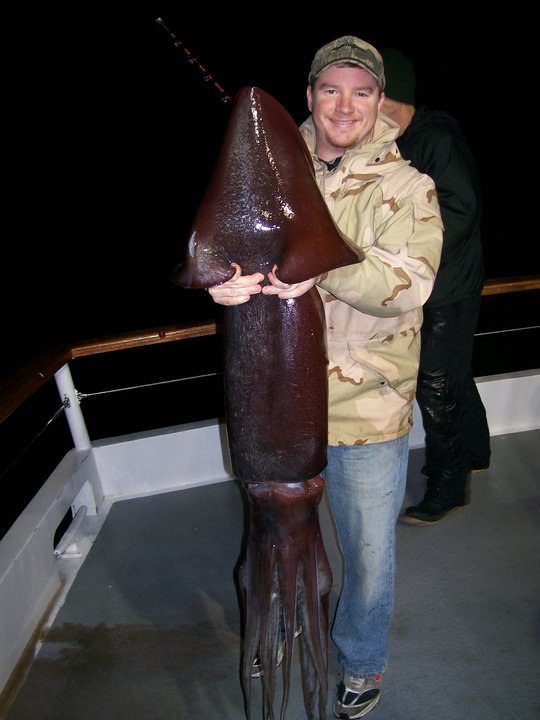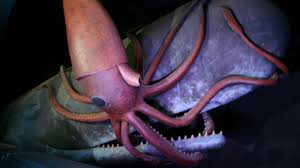The Humboldt is a large predatory squid living in the waters of the Humboldt Current in the Eastern Pacific Ocean. It is commonly called jumbo squid, jumbo flying, pota, or diablo rojo. The Humboldt Squid (specie Dosidicus gigas) is among the largest of squids, with a length exceeding 6 ft. and mass weight of up to 100 lbs. It has an average life span of one year, but can live up to two years. Dennis Bryant reported in Maritime Professional in November 2015 that the Humoldt’s brain is larger than might be assumed, leading some to believe that it may have intelligence comparable to a dog. The Humboldt’s three hearts pump purple blood throughout its body.
Behavior
Although the Humboldt has a reputation of aggression towards humans, this behavior is mostly manifested during feeding times. The Humboldt has also been known to attack recreational scuba divers and render their deep-sea cameras inoperable. Smithsonian’s Friends of the National Zoo reports that the Humboldt may attack divers when threatened and will continue to put up a fight even after they have been caught, blasting their captors with water and black ink. At other times, the Humboldt is likely to be passive or just curious.
Similar to other members of the subfamily Ommastrephinae, the Humboldt possesses bio-luminescent photophores, and is thus capable of quickly changing body coloration called Metachrosis.
Fox Meyer reported in the Smithsonian’s Ocean Portal in 2015, “many thousands of color-changing cells called chromatophores just below the surface of the skin are responsible for these remarkable transformations. The center of each chromatophore contains an elastic sac full of pigment, rather like a tiny balloon, which may be colored black, brown, orange, red or yellow. If you squeezed a dye-filled balloon, the color would be pushed to the top, stretching out the surface and making the color appear brighter — the same way chromatophores work. A complex array of nerves and muscles controls whether the sac is expanded or contracted; when the sac expands, the color is more visible.”
It rapidly flashes red and white colors while hunting, earning the name “diablo rojo” or red devil among the shrimp fishermen off the coast of Mexico. The Humboldt squid can rapidly change colors to flash signals and communicate within its shoal, or disguise itself from predators, flashing much too fast for the human eye to see all the color transitions.
Jane J. Lee of the National Geographic reported in January 2015, “When Humboldt squid want to go incognito, they start to flicker like a computer screen on its last legs. The animals use special skin cells to produce waves of red and white that scroll across their body. Most likely, the predators are trying to match the undulating pattern of sunlight filtering through the water.” They flicker “like light reflecting on the bottom of a swimming pool,” says Hanna Rosen, a doctoral student at Stanford’s Hopkins Marine Station in Pacific Grove, California.
Ecology
The Humboldt squid is a carnivorous marine invertebrate (phylum Mollusca; class Cephalopoda) that can move in shoals of up to 1,200 individuals at a time. They swim at speeds of up to 15 mph propelled by water ejected through a hyponome or siphon, and by two triangular fins. Their tentacles, with 100-200 suckers, each lined with razor-sharp teeth, are used to grip their prey.
Prey
The Humboldt squid feeds primarily on small fish, shrimp, mollusks, crustaceans, cephalopods, and copepods. It uses its barbed tentacle suckers to grab its prey and slices and tears the victim’s flesh with its beak and radula, a rasping tongue-like organ covered with rows of tiny teeth to chop food into bite size pieces before swallowing. They approach prey with all 10 appendages extended forward in a cone-like shape. Upon striking distance, they open their eight swirling and grasping arms, and extend two long tentacles covered in sharp teeth-like structures, grabbing their prey and pulling it back towards their parrot-like beak, which can easily cause serious lacerations and tearing of human flesh. These two longer tentacles can reach full length, grab prey, and retract so fast that almost the entire event happens in one frame of a normal-speed video camera.
Another method of hunting is by pulling the prey to great depths until it faints. The Humboldt squid is also known to quickly devour larger prey when hunting in shoals. Recently, Humboldts were seen engaging in cooperative and coordinated hunting.
Shoals of Humboldt surface at night to hunt lanternfish. Many squids cannibalize other species but never those of their own. The Humboldt can cannibalize other jumbo squids that have been maimed or captured in nets, including its own specie.
Predators
Sperm whales, sharks, seals, swordfish, and marlin feed on the Humboldt squid of all sizes, while gulls and large fish capture the juveniles.
Distribution
The Humboldt squid lives at depths of 660 to 2,300 ft in the eastern Pacific (Chile, Peru), ranging from Tierra del Fuego, an archipelago shared by Chile and Argentina in the southernmost tip of South America and northward to California. It gets its name from the Humboldt Current, in which it lives, off the coast of South America. The Humboldt squid has been appearing farther north, into the waters of Oregon; Puget Sound, Washington State; British Columbia, Canada; and Sitka, Alaska.
Reproduction
The ability to change colors may be a factor for mating. The males may engage in Metachrosis to get the attention of females. Experts know little about how the Humboldt squid spawns mainly because the squid spends most of its life at depths unsafe for scuba diving. Their eggs are laid in hidden places at the bottom of the sea, and have never been observed in nature. The Humboldt reproduces only once in their lifetime.
Fishing
Electronic tagging has shown Humboldt squid undergo “diel” vertical migrations, which bring them closer to the surface from dusk to dawn. Fishermen exploit the Humboldt’s penchant for lanternfish by using lights to lure them near the boat.
Status
The Humboldt is heavily fished off the coast of Mexico, but because ecologists know little about the size of its population, it has yet to be determined whether this practice is sustainable or not. Due to a dearth of information regarding the Humboldt squid, it is not protected by CITES or the IUCN Red List.
Protection
The Humboldt is fished commercially, predominantly in Chile, Mexico and Peru. In light of the heavy fishing and short lifespan of the Humboldt, the Friend of the Sea (FOS) releases certifications to fisheries and aquaculture firms that maintain sustainable fishing methods of the Humboldt squid.
FOS is an international certification program for products from sustainable fisheries and aquaculture. Over 500 companies in over 50 countries rely on FOS to assess sustainability of their seafood origins. Accredited independent certification bodies run the audits, based on best and updated scientific data.
Sustainable fishing
Friend of the Sea has recently concluded an audit of Seatec Chile for Humboldt squid fishing, and the company can proudly continue to display the international sustainability seal of approval on its delivered products.
Seatec Chile, a premium supplier of calamari products, relies on artisanal fishing, using a hand-made tool called “Tota,” which is a type of harpoon. The fishing of the Humbolt Squid occurs in the Coquimbo Region with a Tota being thrown into a depth of about 20 meters, and then hauled back up by hand. Once at the surface, a hook is used to heave the squid up onto the ship.
“Seatec Chile is committed to follow and comply with the standards on the sustainable fisheries and recognize the importance of Friend of the Sea in this field,” said Pablo Lizana Walsen, Seatec’s CEO. “That is why we are very happy to have accomplished the renewal of our certification.” Seatec Chile is a premium supplier of various natural calamari products based in Santiago, Chile, and is proud to use traditional manual fishing methods. Each giant squid is custom caught one at a time, making this type of fishing quite selective, as there are no unnecessary discards or bycatch.

